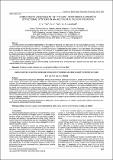Search
Robustness assessment of precast reinforced concrete structural systems in an accidental design situation

View/
Date
2021Publisher
BrSTUUDC
624.012Citation
Tur, V. V. Robustness assessment of precast reinforced concrete structural systems in an accidental design situation / V. V. Tur, A. V. Tur, A. A. Lizahub // Vestnik of Brest State Technical University. – 2021. – № 3 (126). – P. 31–39.Abstract
The article presents the simplified implementation of the method of alternative load paths based on the energy balance approach. This method should be used to checking the global resistance of a damaged structural system after the occurrence of an accidental event. It is necessary to provide (reserve) enough ties with the required continuity and ductility in the original prefabricated structural system to ensure the integrity of the damaged system. We consider the system of ties as the “second line of defense” of the structural system after the exhaustion of the flexural resistance of its elements. The continuity and ductility of the tie elements provide a resistance of the damaged structural system under an accidental combination of actions by mobilizing alternative load paths after the support or key element has been removed. Ductility is the ability of the tie to obtain significant plastic bond elongation before rupture. The ductility is important properties of the ties for redistributing internal forces and getting large deflections. It is necessary for the realization of the chain (membrane) effect, as well as a measure that provides energy absorption (damping) during the dynamic application of an accidental action after the vertical support losing. The article presents analytical solutions and the working example for the design of horizontal ties in precast hollow-core slabs floor, which are obtained based on the energy approach.
Annotation in another language
В статье представлена упрощенная реализация метода альтернативных траекторий нагрузок на основе энергетического подхода. Этот метод следует использовать для проверки глобального сопротивления поврежденной конструктивной системы после реализации особого события. Для обеспечения целостности поврежденной системы в исходной сборной конструктивной системе необходимо предусматривать (резервировать) достаточное количество связей, обладающих требуемой степенью неразрывности и пластической деформативности. Система связей рассматривается как «вторая линия защиты» конструктивной системы после исчерпания ее элементами сопротивления изгибу. Неразрывность и пластичность связевых элементов обеспечивают сопротивление поврежденной конструктивной системы при особой комбинации воздействий за счет мобилизации альтернативных путей нагрузки после удаления опоры или ключевого элемента. Пластичность подразумевает собой способность связи достигать значительного пластического удлинения перед разрывом и является важным свойством связей для перераспределения внутренних сил и развития больших прогибов. Что в свою очередь необходимо для реализации цепного (мембранного) эффекта, который обеспечивает поглощение (демпфирование) энергии при динамическом приложении особого воздействия после удаления вертикальной опоры. В статье представлены аналитические решения и пример для расчета горизонтальных связей в перекрытии из сборных пустотных плит, полученные на основе энергетического подхода.
Collection
- № 3 (126) 2021 [26]

Это произведение доступно по лицензии Creative Commons «Attribution-NonCommercial» («Атрибуция-Некоммерчески») 4.0 Всемирная.